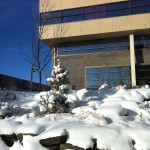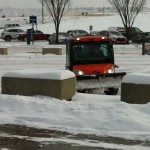 As Lethbridge woke up buried under nearly two feet of snow the morning of Friday, Jan. 11, the U of L Grounds department was clearing up the last bit of white stuff and sanding icy areas across campus.
As Lethbridge woke up buried under nearly two feet of snow the morning of Friday, Jan. 11, the U of L Grounds department was clearing up the last bit of white stuff and sanding icy areas across campus.
Grounds crews were able to clear campus so quickly because the snow fell overnight Thursday when crews had better access to the parking lots. With low traffic volumes, staff were able to work much faster than when crews have to work around vehicular and pedestrian circulation.
Future snowstorms may fall too close to when morning traffic arrives, in which case Grounds may not have access to parking lots until the following night, therefore the campus may not be as well cleared when the public arrives the morning of a heavy snowfall.
 Fun facts about the Jan. 10-11 snow fall:
Fun facts about the Jan. 10-11 snow fall:
- The average home in Lethbridge has about 112 sq. m. of driveway and sidewalk to clear snow from.
- The South Plaza between the Wellness Centre and the library is 3,269 sq. m., or roughly equivalent to 29 homes.
- From the start of operations on Jan. 10 until 10 a.m. on Jan. 11, seven Grounds employees put in more than 110 hours clearing snow.
- Parts of campus such as the stairs at the Students’ Union Building were cleared more than 10 times during this period.
- The equipment clearing campus roadways ran continuously from 5 a.m. Jan. 10 to 10 a.m. Jan. 11 – excluding the hours between 10 p.m. and 1:30 a.m.
Snow Shovelling Safety Tips
Clearing snow is part of the Grounds department’s work repertoire, and crews are well versed in proper snow shovelling safety.
While clearing sidewalks and driveways may seem like a simple task at home, it can be backbreaking work, so be careful that you don’t actually break your back!
The list below includes safety and injury reduction tips created by the Snow & Ice Management Association, Inc. (SIMA) and its website, www.GoPlow.com made possible by Bobcat Company at www.bobcat.com.
- Wear breathable layers: SIMA suggests wearing layers of loose clothing so layers can be peeled off. Avoid wearing heavy wools, manmade materials or other materials that don’t allow perspiration to evaporate.
- Wear good shoes or boots: SIMA suggests wearing quality outdoor winter wear such as waterproof boots with good traction. Good traction is critical to ensuring that you don’t slip and fall.
- Loosen up: Take a few minutes to stretch. Shovelling snow is a workout so you need to stretch to warm up your muscles particularly because you are shovelling snow in the cold weather. Stretching before you start shovelling will help prevent injury and fatigue.
- Push don’t lift: If you push the snow to the side rather than trying to lift the snow to remove it, you exert less energy thereby placing less stress on your body, so push as much as possible within reason. If deeper snow is in need of removal, take it in layers.
- Drink up: SIMA recommends taking frequent breaks and staying hydrated. You should drink water as if you were enduring a tough workout at the gym or jogging.
- Utilize equipment: Whenever possible, utilize equipment that can remove more snow with less time/effort, to increase your efficiency and reduce the amount of labour needed.
